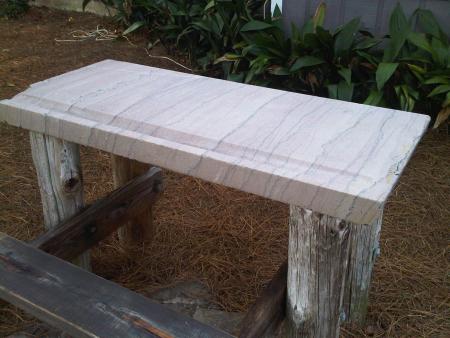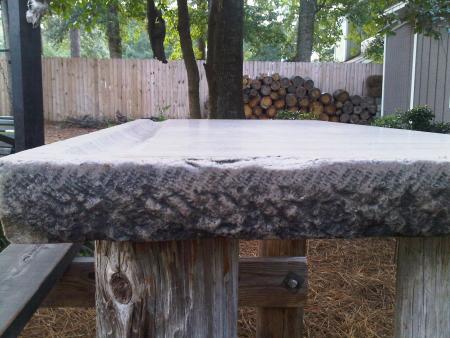Marble slab w/ groove from an old printing shop.
I am new to this board and would like your opinion on something. About 10 years ago, I got a thick slab of marble out of a 170 year old newspaper print shop here in Valdosta, GA. The slab is what I believe to be pink marble. It has a slight pink hue when dry but bright pink when wet. It is approx. 52” x 32” x 4”. There is rounded groove, offset close to one of the 54” sides and approx. 3.5” wide. The groove is bellied out deeper in the center. I suppose this is for liquid collecting? On the two short edges of the stone, hand chisel marks are visible. The rest of the surfaces are polished very smooth. When I originally got this stone, it was covered with a lot of very old ink. There was also a riveted hood with ducting, that vented outside, above the table( I got this as well, but no pictures, sorry). The slab was supported about 45” above the floor, on a wooden timber frame. I am trying to find out what this thing is. I have since installed it in my back yard as a table and am always getting questions about it. Any help would be greatly appreciated.

IMG00101-20100824-1724.jpg

IMG00102-20100824-1724.jpg
Might it have been for resurfacing litho stones?
Daniel Morris
The Arm Letterpress
Brooklyn, NY
It sure does look like a litho stone, i think they were mostly limestone, i have one for a stone myself. Maybe that groove is so your tools don’t roll off the stone, never saw one grooved like that. Dick G.
The groove had a lot of ink build up in it. I thought it may have been filled with ink. I also considered that the hood may have been used for removing fumes from melting and casting lead type. There were also many linear cut marks on the top surface. Kind of like knife score marks. It is definitely a curious piece and i really love it.
My guess would be that at one time newspaper pages were spaced out on this stone, the cut marks could have come later as newspapers were changing from lead type to pastups. Why the groove was filled with ink i don’t know, but after 50 years of letterpress printing most grooves in my body are filled with ink also. Dick G.
How did you get all the old dried ink off?
I would have thought that this was an ink-mixing/grinding slab… I suspect that at some time in history the printing firm mixed up its own ink, or adjusted available ink to suit its particular presses and paper.
Circuit5, that might explain the hood over it, even the cut marks on the stone could have been from an ink knife maybe. Dick G.
I do not believe that this table was printing-related at all! I have never seen anything like it in any old equipment catalog or print shop. Stand is too high. Hood indicated that whatever transpired on top of it required that the fumes be ventilated. Trough along edge is to drain whatever was being washed/cleaned. It is hard marble and not smooth limestone (as litho stones are). Printer’s stones were generally only about 2” thick.
Those are my observations.
Rick
I got the ink off with M.E.K. and a chemical we use in the stainless steel fabrication industry called Oakite 33. It is a mixture of acid used to passivate stainless steel. Elbow grease was also required. Some of the ink had penetrated the stone which is still visible in the veins of the marble. There is still some ink caked on the rough cut edges as well. The timber frame that was under the slab when I got it, was certainly a later addition. I believe the hood to have only been about 100 years old. Maybe it was just re purposed. I really appreciate all the help yall are giving me on this. You all have some great ideas.
I’d think twice before sitting on that bench! If the legs rotted they might slide out, and rotate on the bolts causing the marble to slide down onto your lap. Ouch.
I agree with Foolproof. It appears to me to be something architectural, perhaps a porch landing with a channel to allow rain to run off. Perhaps it was replaced and the pressroom grabbed it as a table for cleaning forms.
The first thing which entered my mind was that it could possibly be the base/floor of a large urinal. I have seen similar items in old public buildings. The channel there for obvious drainage purposes.
Years ago we had something similar at a camp I went to. We used it for cleaning fish. I remember the adults sharping their knives on the surface while we were dulling them cutting open our catch of the day.